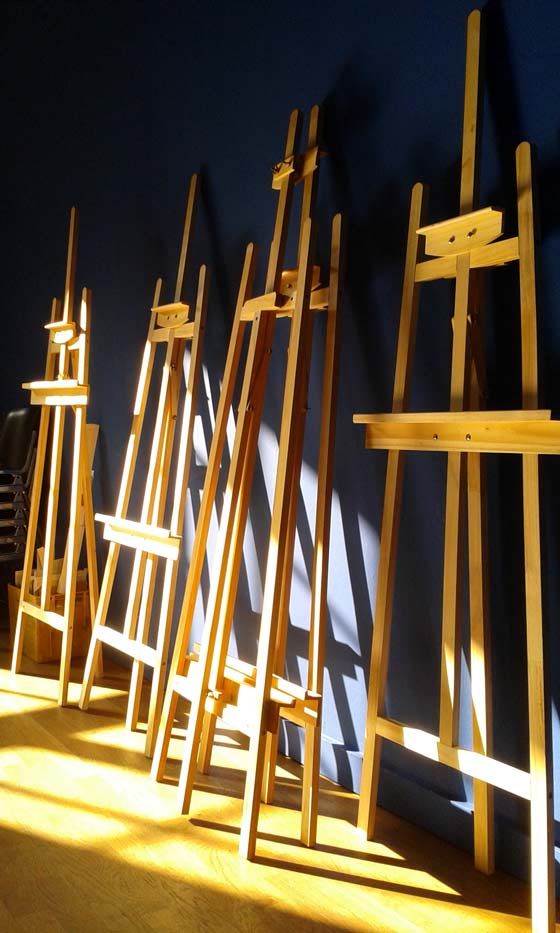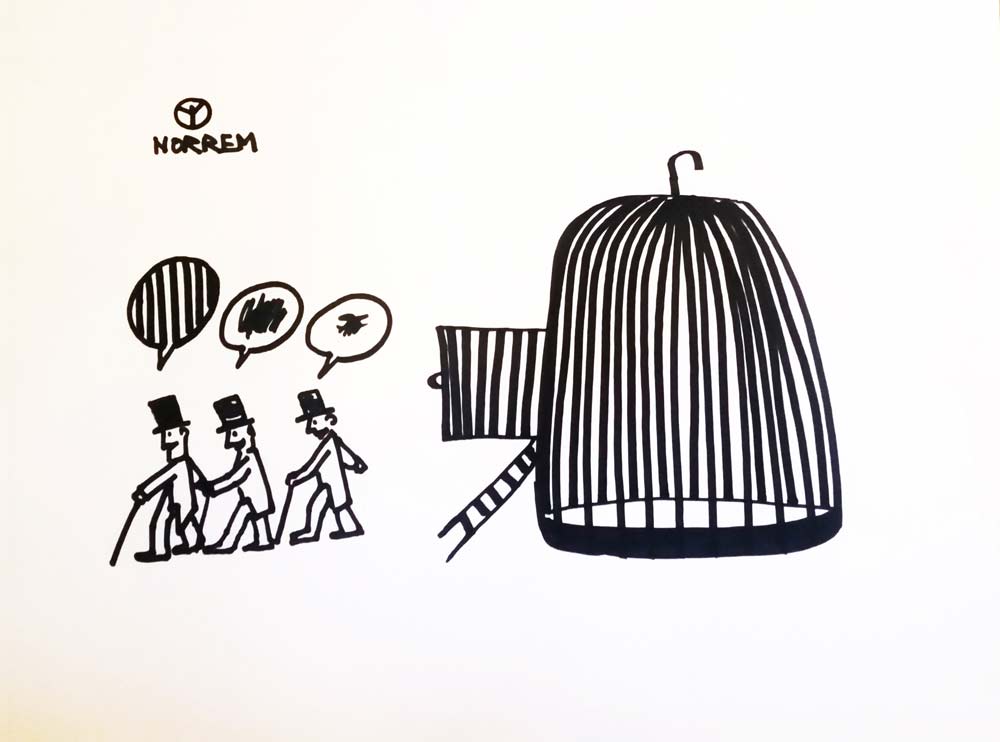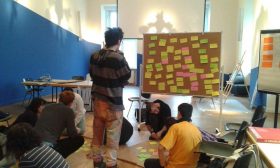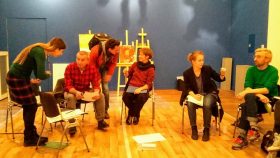A boat made of wood and painted canvas strips, a yodeling flamingo, a photograph of turquoise tiles from a Berlin subway station, two cake replicas, metamorphosed Ugaritic letters, a fisherman, a play. What do they all have to do with each other? They are all going to be exhibited at the Jewish Museum Berlin this summer.
And what do a car-body painter, well known in his native Iraq, an architect from Syria, a young Egyptian chef, a painter from the former Soviet Union, a Greek doctoral student, and a social worker from right here in Berlin have in common? They will all be exhibiting at the Jewish Museum Berlin this summer.
On July 12 a group exhibition entitled The Blue Room opens. It will be the high point of a meeting project that I have been supervising since January.
As an artist who also works as a guide at the museum and isn’t originally from Germany, I found this project a very welcome challenge. I was particularly interested in working over a longer period of time with one group — unlike guiding tours — and indeed a group consisting of a wide range of artists I hadn’t previously known as well as those interested in the arts. In the open call that we sent out to various organizations and platforms, we neither set an age-limit nor demanded a portfolio or proposal. We decided to invite all the people who showed interest. We wanted to offer a space that shaped itself to the needs and wishes of the participants. It could become a professional art exhibition as much as a summer school-like course. Since mid-January we have been offering studio space, materials, workshops on a number of artistic techniques, the possibility to get to know the Jewish Museum Berlin, and a mandatory weekly meeting, all of which will continue through the end of July of this year.
Right from the first encounter some of the participants expressed their concern at being perceived “only” as refugees: is that judging externally? Stigmatizing? Is it about their legal status or their art? Will the exhibition have a theme? Do we have to talk about fleeing and trauma? I found it important to leave things open, to accept the various opinions and “simply” watch how the group dynamic developed.
What would it be like, for some participants, to be led by three women? What reactions would I get when I “outed” myself as an Israeli and a Jew? These questions went through my head beforehand. It was helpful at our second meeting to visit the special exhibition by Eran Shakine, A Muslim, A Christian and a Jew (more on that show at our website).
The witty and clever way in which Shakine handles “difficult subjects” eased the discussion on such topics. Just like Shakine and his protagonists, we are simply looking for happiness and fellow humans. Our desires, dreams, and hopes ultimately reside very near one another. That’s how we interacted with Shakine’s works and found inspiration to create our own drawings. I was particularly moved by the moment when one participant — a professional cartoonist from Syria — noted that this was his first cartoon in over 20 years.
It took seven meetings until we were a real group. By then the focus was on the creative work: the meetings shouldn’t become too talk-focused. From the beginning we were all speaking both German and English and taking care not to use excessively complex language or speak too quickly since both languages are relatively new for most. We did want, though, that everyone have the chance to use and improve their German. We offered various workshops and museum visits, as well as cooking and eating together at the Academy.
It was important to us that the content, motifs, and composition of the process-oriented art and meeting projects didn’t feel forced. Although it takes more time, everything was decided democratically. For this, we’re using ever changing, colorful systems to keep the decision-making process interesting and surprising. We also get to know each other better as individuals that way and at the same time, shape the program together as a group. Thus “dialogue” was the preferred theme for the exhibition and any misgivings from the first meeting could be cleared up.
“Democracy is crap,” said one young Syrian, after the title of the exhibition was chosen democratically. I could totally understand him. I had also wanted a different title and had already been wondering how democracy and individual artistic aspirations are supposed to be reconciled. To what extent can I, as the artistic head of the group and exhibition, influence what gets shown? Does the exhibition have priority, or the process and the encounter? If I’m not the one who decides who may show, and what work, what subject, and what title get picked, what is actually my role? How free am I to realize my own ideas? How free are the artists to realize their ideas? How will individuality and heterogeneity claim their own room in our “blue room?”
The show’s title contains in it a physical as well as a psychological space. On the one hand is the room in which the exhibition takes place and where we meet each week, and it is in fact painted blue. So the title shifted the process of our meetings, bringing it into focus. In this room, the participants can develop their artistic works individually. The blue room should also be understood as a place of retreat — a sanctuary. The title can be interpreted as an abstract, more fluid space to which disoriented people betake themselves. The participants as well as the visitors are seen as nomads; they’re on the road, they haven’t yet arrived. They leave much behind: memories, families, friends; and they carry thoughts and feelings with them that give them stability and security in the times when they hover in this “blue room,” without knowing where the path (their lives) will take them.
There are also, of course, other associations attached to the color blue: from Picasso’s blue period to the Blue Room in the White House, from Prussian blue to indigo, and all the way to the Bavarian, Greek, and Israeli flags. That’s how eclectic the group exhibition should be! The blue room additionally plays with the concept of the “White Cube” — presenting art in a white room, to avoid interactions between the architecture (context) and artwork. By contrast, our blue room, in which the exhibition The Blue Room will take place, is not a neutral room for us.
There are certainly still many negotiation processes ahead of us before July, related both to art and group dynamics. A group exhibition with so many different artists, and the task of understanding and organizing art so variously, remains in any case incredibly fascinating.
Atalya Laufer is an artist and has worked since 2014 as a guide at the Jewish Museum Berlin. More on her in an artist portrait on our blog as well as at her website: atalyalaufer.com.



